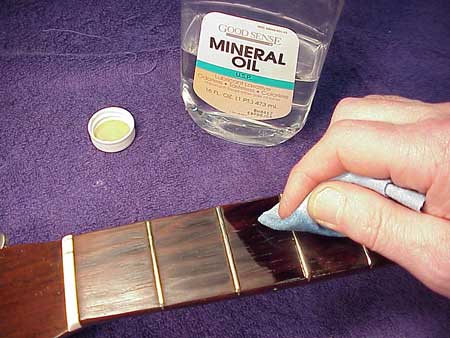Most of the time, water and guitar polish are ineffective in removing this kind of goo. Mineral spirits or naphtha (lighter fluid) won't injure the finish, and will usually dissolve the sticky residue:

Apply the solvent with a disposable cloth, and turn the cloth often to avoid smearing the adhesive around the finish. A light buffing with a damp cloth should take care of any solvent streaks left behind.
As you play your guitar oils from your hands, and other dirt gets mashed onto the fingerboard. In fact, the fingerboard is the dirtiest part of most guitars:

When you're changing strings, you have an opportunity to wipe down the fingerboard and really clean things up. (By the way, it doesn't hurt any guitar to take all the strings off at the same time.) If the dirt buildup is really bad, simply wiping with a damp cloth won't suffice. Get some extra fine steel wool (grade #0000) and scrub the fingerboard gently across its surface, parallel to the frets:

As you scrub, make sure you don't snag the ends of the frets! There's usually no need for cleaning agents, because the steel wool will scrape the dirt away. Some players talk of "feeding" the unfinished surface of the fingerboard with oil. Fingerboards are not actually hungry and don't really need to be fed, but a light coating of oil gives them a finished and clean look. If you do choose to oil the fingerboard, do it with care. Use a tiny amount of lemon oil or mineral oil on the rag, wipe it on the fingerboard, and then wipe it all off. You don't want to saturate the fingerboard, and you don't want a lot of oil running down into the fret slots. If there are cracks in your fingerboard, consider having them filled professionally, and don't get oil in the cracks. Generally, you'll want to stay away from linseed and other natural vegetable oils, which become sticky and gummy over time:

This kind of fingerboard cleaning should be a once-a-year event, at the most. Too much scrubbing and oiling can easily do more damage than good.
Lemon oil and other oils are often sold as instrument polish. None of these will injure any finish, and can be used without fear of damaging the finish itself. The oil type cleaners will tend to remove oil soluble dirt, BUT, it is very important to realize that oils and polishes can penetrate any little breaks in the finish, and may make quite a mess over time.
A guitar with cracks or a "crazed" finish, should be approached with utmost caution. Oily polishes will leach right through the cracks in the finish and stain the surface of the wood, and the stains will "bleed" and become more ugly as the years go by:

The creamy white commercial guitar polishes will leave a high shine, and will clean a new finish beautifully. But an old, crazed finish will absorb the polish and will look like an old dried riverbed with white outlined cracks:

Some creamy polishes have a tendency to build up on the surface, leaving a film behind. This film may look shiny and clean, but it may actually be somewhat likely to water-spot and collect dirt. So, it is possible to build up a waxy finish coating that in itself requires more maintenance than the finish underneath. If you have a problem with one brand of creamy polish, try cleaning it off with the light detergent and water on a cloth, then switching to another brand.
Very light surface scratches may often be "rubbed out" by hand, using a variety of automotive and plastic polishing compounds. For recommendations about this sort of polish, see your local professional luthier.
I'm particularly fond of Novus #2 plastic polish. It leaves a high gloss without a serious residue:

Follow the #2 with the #1 spray to leave a static-free clean surface:

More